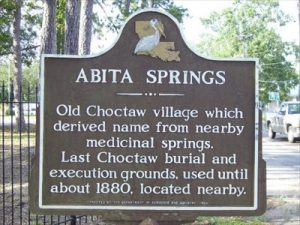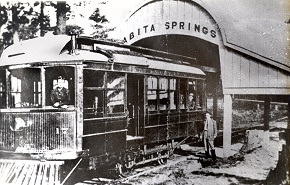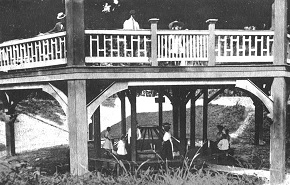Abita Springs was first settled by the Choctaws who found the natural springs possessing an excellent quality and further named the springs, "ibetap" which means fountain. According to legend, a handsome native Orleanian of Spanish descent named Henriquez was visiting the area of Abita Springs, and met and married a beautiful Choctaw princess named Abita. Shortly after they married and moved to New Orleans, Abita became very ill and Henriquez was told by advisors to bring his bride back to Abita Springs to drink of the healing waters and to bathe in the bubbling springs. She was cured in a month's time. Many settlers of Anglo-Saxon or Irish descent settled the area around the 1830s. After the settlers came to the area, the waters were tested and found to have a high degree of medicinal quality. Abita Springs became a summer and winter resort known for its healing waters. Many hotels and resorts were built to support the number of people visiting the area.

Trains were used in Abita Springs from 1884 -1910 as the primary means of transporting people and supplies to Abita Springs. At this time, trains transported hundreds of visitors to Abita Springs on a daily basis. On June 26, 1887, the first excursion train arrived in Abita Springs with over 500 people after a two and a half hour trip from New Orleans.

Abita Springs was bustling with activity and developed into a very fashionable resort town with numerous hotels, restaurants, summer homes and plenty of entertainment. Guests spent entire summers in the area. One of the famed hotels in Abita Springs was the New Abita Springs Hotel. The Mutti Hotel--a comfortable, roomy hotel with modern conveniences and added attractions-- was another famous hotel. The Long Branch Hotel was another famous Abita Springs hotel.
The site of the Abita Pavilion was developed between 1878 and 1880. It contained the purest water. The Abita Pavilion contained three springs, which was part of the Ozone Belt and was called "magnesium water". The water in the Pavilion was protected by a bronze enclosure.

The Abita Pavilion is still in existence today, even though people no longer flock to its statuesque presence for the bubbling springs. Likewise, hotels and resorts are no longer in existence, but residents and visitors to Abita Springs still enjoy a peaceful setting with small-town charm.




Add a comment to: History At A Glance: Abita Springs, Land of Healing Waters